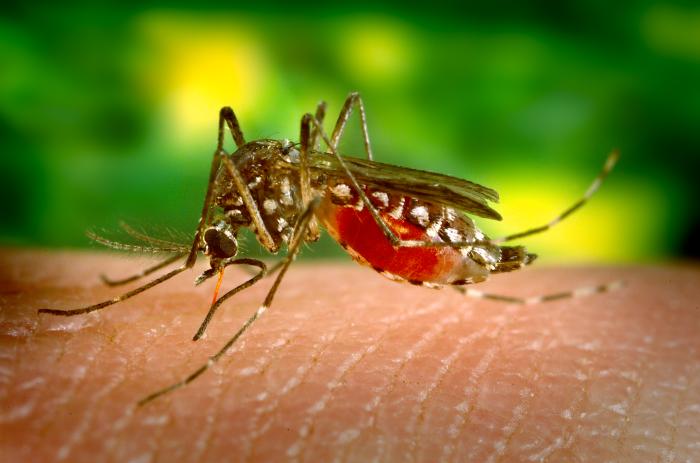Posted: Wed, 15 Jun 2011 01:44 PM - 11,586 Readers
By: AgriLife Communications

photo by James Gathany
The high temperatures and lack of moisture from the extended drought are having a serious impact on insects as well as humans, according to Texas AgriLife Extension Service and Texas AgriLife Research entomologists.
“Summer is typically a busy time for many insects,” said Wizzie Brown, an AgriLife Extension integrated pest management specialist at the agency’s Travis County office. “In the Austin area, we’ve been getting calls from residents who say they are noticing an increase in pill bugs getting into their homes, as well as more wasp and fly activity in and around their houses.”
Mostly, the pill bugs and wasps are just seeking moisture and are migrating toward homes where people are irrigating their lawns and gardens, she said. As for the flies, the increased heat is making garbage decompose faster and stink more, drawing them to it and providing them with both a food source and breeding location.
Brown added that June bugs — more accurately May or June beetles — a common sight this time of year, have not been as active recently because their major flight came earlier this year.
“We’ve seen the beetles earlier this year, and I remember seeing a lot of them in late February and March,” she said. “That’s because it was unusually warm here earlier in the year and that warmth, plus whatever moisture we got then, triggered their proliferation. But now that it’s even hotter and there’s even less moisture, they’ve become less active.”
“I’ve also had some calls from people complaining about chigger bites they’re gotten while outdoors, Brown said. “But so far I don’t know if those are really chiggers or flea bites as nobody has brought me an insect sample for identification.”
“While I’ve heard of increased numbers of fleas in the San Antonio area, I don’t think the evidence indicates there’s been a larger-than-usual proliferation this season,” said Molly Keck, AgriLife Extension integrated pest management specialist for Bexar County. “Fleas always become more active around summertime; it’s just that people tend to forget that this happens every year.”
Keck, however, noted that one type of increase in insect activity in South Central Texas and other regions of the state most likely spurred by the prolonged drought is an uptick in scorpion and tarantula migration.
“Both are looking for moisture and a cooler place to live, so they tend to migrate around or even into people’s homes, provided they can find an opening,” she said. “In the case of the tarantulas, the males are also likely migrating in their search for a mate.”
Recently, grasshoppers have been a problem in some areas of East Texas, especially for hay producers, said Dr. Allen Knutson, AgriLife Extension entomologist at the Texas AgriLife Research and Extension Center in Dallas.
“Grasshoppers survive better and grow faster during hot, dry weather, so drought conditions certainly favor their increase,” he said. “With the dry conditions this spring, grasshopper problems are more widespread, and young hoppers often increase in non-cropland areas on weeds around fields. Then as these weeds are consumed or dry out in the summer heat, grasshoppers move to crops and irrigated landscapes, creating problems for many agricultural producers and others.”
On the other hand, drought conditions in East Texas and other areas of the state have significantly reduced some insect activity, Knutson explained.
“Fire ants tunnel deeper into the soil seeking moisture during drought, so their mounds are not as evident as during wet periods. And horn fly populations in rural areas are also reduced during a drought as the manure pats in which they reproduce dry up quickly, limiting their ability to multiply.”
Other recent increase in insect activity statewide has included a greater movement indoors of cockroaches, ants, centipedes and millipedes and crickets, said Dr. Roger Gold, an AgriLife Research entomologist at Texas A&M’s College of Agriculture and Life Sciences in College Station.
“While drought conditions have made life more difficult for insects dependent on standing water for their survival, people should not be lulled into a false sense of security by their apparent absence,” Gold noted.
“While most of the state has had a respite from mosquitoes due to lack of rain, it won’t take long for them to proliferate as soon as some areas get a little much-needed moisture,” Gold said. “This is particularly true of what we call floodplain mosquitoes, whose eggs can withstand drought and are able to produce a new generation just 10 days after a rain.”
He added that now is the optimum time for people to dispose of and outdoor containers, bottles, jugs or other receptacles, as well as tires and other items that might trap standing water and provide a potential breeding ground for mosquitoes after a rain.
“People may also be deceived by the fact that they’re not seeing much termite activity, but termites are still there and we’ll likely start seeing swarms of them again shortly after a rain,” he said.
Gold noted the same is true of fire ants.
“Just because people aren’t seeing as many mounds, they shouldn’t assume their fire ant problems have been resolved. The mounds will pop up again and ants will be on the surface again once there’s enough moisture.”
“However, I’m sure most people in the state would gladly endure a few mosquito or fire ant bites if these came about as the result of a good rain,” he added.